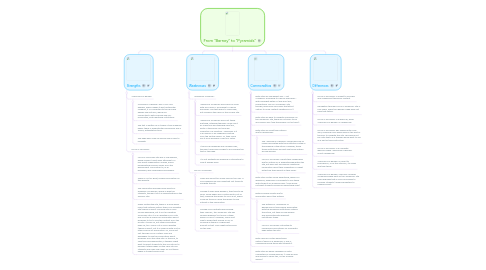
1. Strengths
1.1. "Taxonomy of Barney"
1.1.1. "Taxonomy of Barney" has a .com URL address, which makes it less trustworthy. However, it IS connected to the Ig Noble awards and lectures, which are connected to both Harvard and MIT universities, both reputable institutions.
1.1.2. The text is written as if it were a true academic paper; there is sophisticated vocabulary and a formal, authoritative tone.
1.1.3. The page does load up quickly and is easy to navigate.
1.2. NOVA's "Pyramids"
1.2.1. NOVA's "Pyramids" site has a .org address, which makes it most likely attached to a non-profit organization. Indeed, public broadcasting receives funds from the government. The content is, in all likelihood, well-researched and reliable.
1.2.2. There is a lot of great, reliable information on this website.
1.2.3. The information provided uses plenty of academic vocabulary, which is great for students, though it isn't as sophisticated as the "Barney" site.
1.2.4. When visiting the site, there IS a drop-down menu that notifies visitors there is an updated site (which is good). The new site is more visually appealing, but it isn't an updated "Pyramids" site. It is an updated NOVA site; one must do a search for information about pyramids to try to find the content from the old site. It pops up, but other information pops up, too. Some of it is more updated (which is good), but it is mixed in with a lot of other sources of information. So, one must sort through LOTS of other clips and webpages to find the information about pyramids from the other site. In the end, to save time and aggravation, a teacher might want to direct students to the OLD site or to preselect other pages off the NEW site for students and make QR codes for just those pages a student should visit.
2. Weaknesses
2.1. "Taxonomy of Barney"
2.1.1. "Taxonomy of Barney" does have an issue with ACCURACY according to CRAAP principles. The text refers to Chernobyl, but misspells the name of the nuclear site.
2.1.2. "Taxonomy of Barney" does not teach anything, although teachers could use it as a resource and teaching idea (e.g., write a "taxonomy" for the main character of a narrative – especially if it is an animal or an imaginary creature from the fantasy genre. Or, they could use it as an example of farce or satire.
2.1.3. It lacks sub-headings and clickable links, though it does have images to accompany the text of the page.
2.1.4. It is not aesthetically pleasing or interesting to look at design-wise.
2.2. NOVA's "Pyramids"
2.2.1. There are almost too many links for the user. A less-experienced user might get lost trying to navigate the site.
2.2.2. Though it does have graphics, they tend to be small. Some pages also contain quite a lot of text, requiring the reader to scroll a lot, which could be tiring or cause the reader to lose interest in the information.
2.2.3. Though more aesthetically pleasing than "Barney," the "Pyramids" site has smallish graphics (but more of them, which is a plus). However, some links lead to pages that require a LOT of scrolling as there is a significant amount of text. This might be tiresome for the user.
3. Commonalities
3.1. Both sites are somewhat "old" – not CURRENT according to CRAAP principles – with copyright dates of 1995 and 1997, respectively. NOVA's "Pyramids" site, though, does have some links that direct visitors to more content updated in 2011.
3.2. Both sites are easy to navigate. Especially on the "Pyramids" site, there do not seem to be any broken links (and there were a lot of them).
3.3. Both sites do credit their authors and/or researchers.
3.3.1. The "Taxonomy of Barney" researchers are no longer associated with the institutions listed in the heading of the article. However, those those institutions do exist and those authors are real people.
3.3.2. NOVA's "Pyramids" credits their researchers and/or authors on a separate page within the site, but does not provide any additional information about their credentials. To what extent are they experts in their field?
3.4. Both sites contain some advertising, which is a weakness, especially if one wants to use these with students on a regular basis. (One would not want students clicking on advertising links.)
3.5. Both provided credits and/or information about the authors.
3.5.1. The authors of "Taxonomy of Barney"are not necessarily associated with the academic institutions listed in the article, but they are real people and associated with different institutions today.
3.5.2. NOVA's "Pyramids" site listed its researchers and authors on a separate page within the site.
